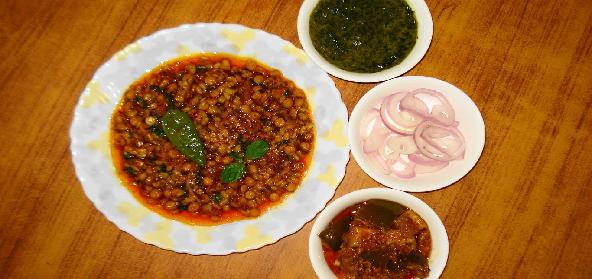Kinema Kya Hai Boss? Fermented Soybeans Ka Dhamaal!
Namaste doston! Ram-Ram to all my readers from the hills! And a warm Kem chho to everyone else tuning in from across the globe! Chef Curry Do’pyaza here, back in your kitchens, ready to spice up your life with another incredible dish! Today, we’re venturing into the beautiful Northeast of India, specifically Sikkim and Darjeeling, for a taste of something truly unique: Kinema!
For my Nepali-speaking friends: Namaste ani swaagatam! This one’s for you!
Kinema isn’t just food; it’s a feeling, a memory, a taste of home. It’s often enjoyed during special occasions, especially during Dashain and Tihar, the big festivals where families come together. The cool autumn air, the smell of Kinema wafting from the kitchen…ah, pure bliss! It’s also a staple during the colder months, providing warmth and comfort. It’s usually prepared in the months of October to December as the weather cools down.
Kinema Ka Itihas (A Little History Lesson)
Kinema has been around for centuries, a traditional food passed down through generations. It’s believed to have originated in the Limbu community and spread to other communities in the region. It was a way to preserve soybeans and provide a valuable source of protein, especially during the lean winter months. Think of it as the Indian miso – a flavourful, fermented powerhouse!
Kinema Recipe: Let’s Get Cooking!
Okay, enough chit-chat! Let’s get our hands dirty and learn how to make this amazing dish.
Preparation Time: 20 minutes (plus overnight soaking)
Cooking Time: 30 minutes
Ingredients:
- 250 grams Bhatmas (Soybeans)
- 2 tablespoons Sarson ka tel (Mustard Oil)
- 1 medium sized Pyaaz (Onion), finely chopped
- 2-3 Hari Mirch (Green Chillies), finely chopped (adjust to your spice level!)
- 1 inch Adrak (Ginger), grated
- 4-5 cloves Lahasun (Garlic), minced
- 1 teaspoon Haldi Powder (Turmeric Powder)
- 1 teaspoon Lal Mirch Powder (Red Chilli Powder)
- 1 teaspoon Jeera Powder (Cumin Powder)
- Salt to taste
- Fresh Hara Dhaniya (Coriander Leaves) for garnish
Instructions:
- Soaking the Soybeans: Wash the Bhatmas (Soybeans) thoroughly. Soak them in plenty of water overnight (at least 8 hours). This softens them up beautifully.
- Boiling the Soybeans: Drain the soaked soybeans. Put them in a pot and cover them with fresh water. Bring to a boil, then reduce the heat and simmer for about 1-1.5 hours, or until the soybeans are very soft and easily mashed.
- Preparing the Kinema: Drain the boiled soybeans and let them cool slightly. Traditionally, the soybeans are wrapped in fern leaves or banana leaves and kept in a warm place for 1-3 days to ferment. However, you can also use a clean container lined with parchment paper. Ensure the environment is warm (around 25-30°C). You’ll know it’s ready when it has a distinct, pungent aroma and a slightly sticky texture.
- Tempering the Kinema: Now for the fun part! Heat Sarson ka tel (Mustard Oil) in a kadhai or pan over medium heat. Mustard oil adds a lovely, pungent flavour.
- Sautéing the Aromatics: Add the chopped Pyaaz (Onion) and sauté until golden brown. Then, add the grated Adrak (Ginger) and minced Lahasun (Garlic). Sauté for another minute until fragrant.
- Adding the Spices: Add the Haldi Powder (Turmeric Powder), Lal Mirch Powder (Red Chilli Powder), and Jeera Powder (Cumin Powder). Sauté for a few seconds, being careful not to burn the spices.
- Cooking the Kinema: Add the fermented Kinema to the pan and mix well with the spices. Add salt to taste. Sauté for about 10-15 minutes, stirring occasionally, until the Kinema is heated through and the flavours have melded together.
- Garnish and Serve: Garnish with fresh Hara Dhaniya (Coriander Leaves) and serve hot!
Tips for Best Results:
- Quality Soybeans: Use good quality soybeans for the best flavour.
- Proper Fermentation: The fermentation process is crucial. Ensure the soybeans are kept in a warm place for the correct amount of time.
- Mustard Oil Magic: Don’t skip the mustard oil! It really enhances the flavour of the dish.
- Spice Level: Adjust the amount of green chillies and red chilli powder to your liking.
Cooking Variations:
- Pressure Cooker: You can boil the soybeans in a pressure cooker for faster cooking. Just add enough water to cover the soybeans and cook for about 3-4 whistles.
- Slow Cooker/Crockpot: You can also make Kinema in a slow cooker. After the fermentation process, simply add all the ingredients to the slow cooker and cook on low for 4-6 hours.
- Oven: While not traditional, you can bake the fermented soybeans in the oven at 350°F (175°C) for about 30 minutes to dry them out slightly before tempering.
Nutritional Information (Approximate per serving):
- Calories: 250-300
- Protein: 20-25 grams
- Fat: 15-20 grams
- Carbohydrates: 10-15 grams
Kinema is a great source of protein, fiber, and essential nutrients. The fermentation process also enhances its nutritional value and makes it easier to digest.
Serving Suggestions:
- Serve Kinema with steamed rice and a side of dal.
- Enjoy it as a side dish with roti or paratha.
- Use it as a filling for momos or thukpa.
- Mix it with boiled potatoes for a simple and satisfying meal.
Ab Kya Soch Rahe Ho? (What are you waiting for?)
So there you have it! A delicious and authentic Kinema recipe straight from my kitchen to yours. Don’t be intimidated by the fermentation process; it’s easier than you think! Gather your ingredients, put on your apron, and get ready to experience the unique and wonderful flavour of Kinema.
Do try this recipe at home and share it with your friends and family. I am sure you and your loved ones will enjoy this tasty and nutritious dish.
Happy cooking, doston!
Chef Curry Do’pyaza signing off!
